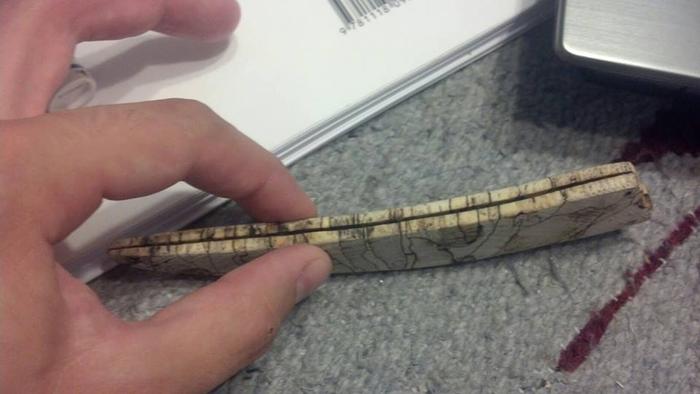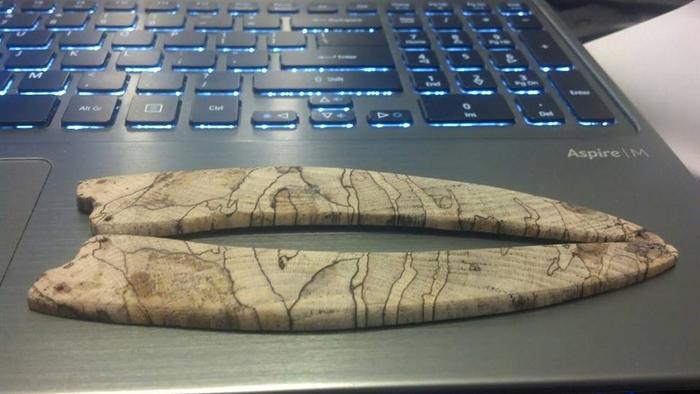Results 11 to 20 of 22
-
05-30-2013, 02:59 PM #11'tis but a scratch!



- Join Date
- Oct 2010
- Location
- Durango, Colorado
- Posts
- 2,080
- Blog Entries
- 2
Thanked: 443
Hi Bruno,
only a hobby-level bookbinder. Folks have asked me to repair old family bibles, and I wouldn't touch such valuable projects... those are for the masters like your mother.
To the original poster: do it right, use CA on the side that hasn't yet experienced it. Anything else will be a waste of all the time you have in this so far. Even with three pins, there will be unresolved, unbalanced forces in your scales that will, over time, distort them.
You've done nice work so far. Don't rush it now."These aren't the droids you're looking for." "These aren't the droids we're looking for." "He can go about his business." "You can go about your business."
-
The Following User Says Thank You to roughkype For This Useful Post:
Jonah (05-30-2013)
-
05-30-2013, 03:05 PM #12

Is there a way to keep weight on the scales when the glue is setting in attempt to keep the shape? The only ways I can think of would glue the scales to the surface.
I'm not applying any pressure in the picture below and you can see there is a slight curve. When I apply pressure on where the pins will be, it the gap is almost entirely closed.

 JimmyHAD:My wife told me if I bought another razor she would leave me ........ and I miss her sometimes......
JimmyHAD:My wife told me if I bought another razor she would leave me ........ and I miss her sometimes......
-
05-30-2013, 03:12 PM #13'tis but a scratch!



- Join Date
- Oct 2010
- Location
- Durango, Colorado
- Posts
- 2,080
- Blog Entries
- 2
Thanked: 443
The glue will pull the scales closer to flat (and now, possibly beyond flat to bent in the opposite direction) as it sets up. You may need to steam/flatten them again... but at least you'll have cancelled the forces acting on only the first glued side. So don't worry about holding them flat while it sets up.
That's my advice, anyway."These aren't the droids you're looking for." "These aren't the droids we're looking for." "He can go about his business." "You can go about your business."
-
The Following User Says Thank You to roughkype For This Useful Post:
Jonah (05-30-2013)
-
05-30-2013, 03:22 PM #14

Oh the joys of trial and error!
Thanks again to everyone that has contributed. I'll post the finished product at some point soon (hopefully).JimmyHAD:My wife told me if I bought another razor she would leave me ........ and I miss her sometimes......
-
05-30-2013, 03:26 PM #15

I'd glue the other side as well, to fix it. Because you definitely don't want them to warp over time when you're already using them.
Seal them with CA all around, and let it rest for some time.Til shade is gone, til water is gone, Into the shadow with teeth bared, screaming defiance with the last breath.
To spit in Sightblinder’s eye on the Last Day
-
The Following User Says Thank You to Bruno For This Useful Post:
Jonah (05-30-2013)
-
05-30-2013, 03:59 PM #16

It's too late for this now but maybe a tip for next time - apply the coating while the scales are held together with double sided tape. When that side is dry, tape again and apply the coating to the other side. I'm assuming here that the tape is strong enough the withstand the buckling - in my experience it's pretty good.
-
The Following User Says Thank You to UKRob For This Useful Post:
Jonah (05-30-2013)
-
05-30-2013, 06:15 PM #17

I CA glued the other side and as some of you said, it caused a mild warp in the other direction. I'll do the same steam bath/weighing down method and try to get them straight again. I also plan on giving them a light sand. There are a few spots where the CA glue grabbed my glove and left some white patches.
I'm starting to wonder if any kind of liquid, not just finishing solution, will cause untreated wood to warp. I just got done rubbing down a scale with some acetone and it caused that to warp a bit as well. Anyone have thoughts on this?JimmyHAD:My wife told me if I bought another razor she would leave me ........ and I miss her sometimes......
-
05-30-2013, 06:52 PM #18'tis but a scratch!



- Join Date
- Oct 2010
- Location
- Durango, Colorado
- Posts
- 2,080
- Blog Entries
- 2
Thanked: 443
Acetone might not have done anything if there wasn't already CA on one side. But heed what quite a few of us have written: with thin wood (or paper, or binder's board), make sure that if you give one side it some treatment, you give the opposite side the exact same treatment, no matter what the glue, solvent, whatever. This will matter both in the near term and the distant future.
With scales, it's a good assumption that the inner surfaces will experience greater humidity over their lifetimes than will the outer surfaces--so it's critical to pay the same attention there as to the sides you'll be admiring.
I unpinned a set of nice but warpy horn scales once and they sprung so far apart I've never been able to flatten them again. I think that someone must have waxed the outer faces but not the inner ones, thus dooming them."These aren't the droids you're looking for." "These aren't the droids we're looking for." "He can go about his business." "You can go about your business."
-
The Following User Says Thank You to roughkype For This Useful Post:
Jonah (05-30-2013)
-
05-30-2013, 07:19 PM #19At this point in time...




- Join Date
- Jun 2007
- Location
- North Idaho Redoubt
- Posts
- 27,069
- Blog Entries
- 1
Thanked: 13249
http://straightrazorpalace.com/works...tml#post720223
I hold them in place to start work slow, use thin aplications until the first coats have "Set" the wood
work slow, use thin aplications until the first coats have "Set" the wood
-
05-30-2013, 09:32 PM #20

That's actually the skeleton I was using for this. Great stuff!
I probably should have clarrified. I applied some acetone on a different set of scales that I had just finished sanding. I was really surprised that they started curling as well.
When I was reading the walkthroughs on CA glue finishes, I missed the part about needing to do the whole scale in one fell swoop. It's all a learning experience.JimmyHAD:My wife told me if I bought another razor she would leave me ........ and I miss her sometimes......


 4Likes
4Likes LinkBack URL
LinkBack URL About LinkBacks
About LinkBacks







 Reply With Quote
Reply With Quote

